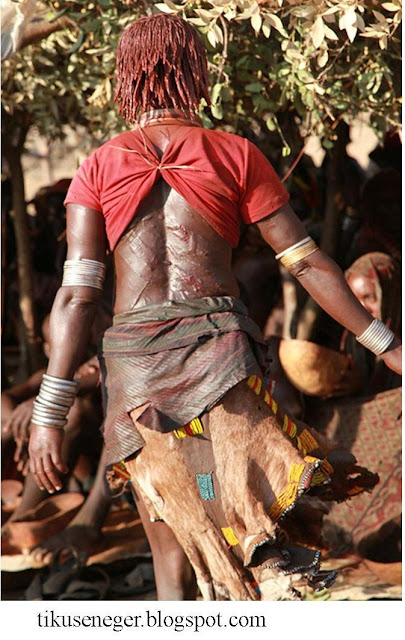Once they reach the waiting maza, the women begin to tease and
verbally harass the men in order to provoke them. The men, who are clutching
long thin sticks, are hesitant to react at first. Finally, however, they start
to beat the women across their bare backs with the switches.
These are not playful strokes, either, but blows often strong
enough to break the sticks in half. Each swipe leaves a gash in the women’s
flesh, but still the women continue to provoke the maza to strike them again
and again.
There are two motives behind this voluntary whipping. First,
it’s a way for the women of the family to show support for the boys who are
undergoing the cattle jumping initiation. The more lashes they sustain and the
greater their injuries, the more devotion they have demonstrated for their
brothers and other male relatives. The second reason is to secure the boys’
loyalty. Now that the girls have proven their commitment, the boys are expected
to look out for them in the future, should they ever be in need of help.
The women’s scars will serve as reminders of this commitment.
Unsurprisingly, perhaps, the Ethiopian government is in favor of ending the
whipping part of the bull jumping ceremony. But for now, the women themselves
want to keep the practice alive.
This young man is having his face painted in preparation for the
ritual: the red paint with white spots is meant to imitate the coloring of a
leopard. Until he performs the jump, no male Hamer may marry, own cattle, or
have children, so it’s an important milestone in his life. Before making the
leap, he is rubbed down with sand to scrub away his sins and is smeared with
cow dung for strength.
Although the cattle jumping
ceremony takes place during the course of one afternoon, the festivities go on
for much longer than that. The invitations are sent out to relatives and
friends in the form of a strip of bark with knots marking off the number of
days until the initiation. Invited guests may have to travel great distances to
arrive at the site. And in preparation, they begin drinking and feasting for
days in advance.
Here, the maza hold the cattle steady. Their age varies according to
when they made their own jumps: boys from wealthier families are usually able
to perform the ritual earlier. Boys stay maza (which translates as
“accomplished one”) until they get married. And when they get married depends
on when their families can find someone suitable, or afford to pay their dowry.
Until then, the young men travel from village to village to assist with the cow
jumping rituals, for which they are paid in food and drink
Around 15 cows and castrated bulls
(representing the women and children of the tribe) are chosen for the ceremony
and lined up in a row. The place of cattle in this ritual signifies their
importance in Hamer life. For these semi-nomadic pastoralists, cattle herds are
both symbols of wealth and an essential source of food, especially in lean
times when they rely on their cows’ blood and milk to survive.
Highlighting the animals’
importance, there are 27 words in the Hamer dialect to describe the differences
in the color and texture of a cow’s coat. A Hamer man is also known by three
names: his human name, his goat name, and his cow name.
Now, the cattle have been rubbed
with dung to make them extra slippery – in case the challenge isn’t sufficient
already! On top of that, the young man being initiated must make his jumps
completely naked, except for two pieces of bark tied across his chest.
He needs to complete four
successful leaps over the animals, but if he falls he’s allowed to pick himself
up and try again. The watching crowd cheers him on with their backs to the
west, which is where they believe all evil should go.
Although this activity is called
bull jumping, getting across the backs of 15 cows and castrated bulls actually
involves a fair bit of running and balancing. Fortunately, the cattle are held
in place by the maza to lessen the likelihood of accidents.
By performing this difficult task,
the Hamer boy is moving beyond childhood into manhood. Until now, he has been
considered immature, sexually unclean, and of low worth, which is why he has
not been allowed to marry. All that will change once he completes his fourth
jump.
The boy – now a man – literally
leaps into responsible adulthood to the roars of his supporters. Yet although
this challenge may be over, more difficult ones lie ahead.
The development of Ethiopia brings
benefits and problems for tribal people like the Hamer. More and more young
people are abandoning traditional ways in favor of urban life – where they
drink stronger alcohol and sometimes find themselves falling prey to less
scrupulous people. It’s a time of transition for the Hamer people, and one that
will no doubt take many years to complete.











No comments:
Post a Comment